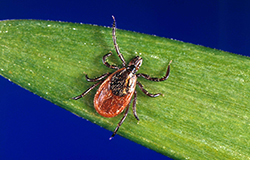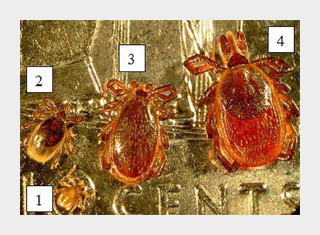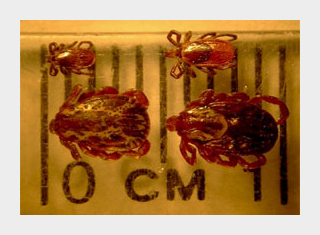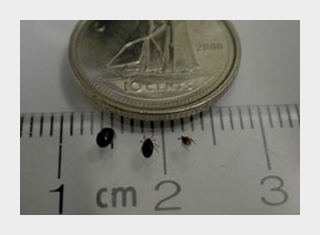About Blacklegged Ticks
 Blacklegged ticks are parasitic animals which are related to spiders. Blacklegged ticks cannot jump or fly. Instead, they seek hosts by climbing on vegetation such as grasses or shrubs and waiting for a host to rub against them. When this occurs, they climb onto the host’s body and eventually attempt to attach and feed.
Blacklegged ticks are parasitic animals which are related to spiders. Blacklegged ticks cannot jump or fly. Instead, they seek hosts by climbing on vegetation such as grasses or shrubs and waiting for a host to rub against them. When this occurs, they climb onto the host’s body and eventually attempt to attach and feed.
Blacklegged ticks feed by attaching their mouth parts to the skin of an animal (including humans) and drinking blood very slowly over a period of days. A tick bite is generally painless. As ticks feed, their bodies expand to accommodate the blood meal. This is called engorgement. If a blacklegged tick is infected with a tick-borne disease causing agent, it can pass this infection along to its host during feeding.
Even if you are bitten by a blacklegged tick the likelihood of disease transmission is not a certainty. First, not all blacklegged ticks are infected with disease causing agents. Second, only nymph and adult stages can transmit infection (larvae need to acquire the disease agent(s) when feeding). And third, blacklegged ticks need time to prepare their bodies to significantly expand with blood and often do not start to feed for the first 24 hours after attaching themselves to a host (Figure 3 and 4). Therefore, transmission of the disease causing agents of Anaplasmosis, Babesiosis and Lyme disease typically require a minimum attachment period of at least 24 hours. This is why performing a tick check is so important.
Tick-borne diseases naturally circulate between blacklegged ticks and wild animals. Animals such as rodents, small mammals and white-tailed deer are the reservoirs (the source) of the tick-borne disease causing agents and the blacklegged tick is the vector (the vehicle) which moves the disease agents between animals. Most wild animals do not become ill from these agents, nor can you become infected with tick-borne disease by consuming meat or handling the pelt from a wild animal. However, there is a risk for these ticks to transfer to you when handling the animal. People and some domestic animals are accidental hosts and can be exposed to the disease causing agent and become ill when they are fed upon by an infected blacklegged tick.
Blacklegged ticks exist in three life stages: larva, nymph and adult. The life cycle of blacklegged ticks takes at least three years to complete and each stage usually survives for up to one year. Blood is required by the tick to move to the next stage. Unfed larvae and nymphs are light in colour and very difficult to see (Figure 1).
Sizes presented in relation to underlying 10-cent coin. Photos reproduced with the permission of Robbin Lindsay, Public Health Agency of Canada. |
 |
Unfed adult female blacklegged ticks are approximately 3 to 5 mm in length; and are distinctly bright red and dark brown in colour; while adult males are smaller than females and are uniformly dark brown in colour (Figure 1). Adult blacklegged ticks are smaller than the more common American dog tick (often called wood tick). American dog ticks have white markings on their backs while blacklegged ticks do not (Figure 2). American dog ticks do not transmit the disease causing agents of Anaplasmosis, Babesiosis and Lyme Disease. |
|
Photos reproduced with the permission of Robbin Lindsay, Public Health Agency of Canada. |
 |
|
 |
Photos reproduced with the permission of Robbin Lindsay, Public Health Agency of Canada. |
 |
Where are Blacklegged Ticks Found?
Throughout Manitoba, the greatest risk of coming in contact with a blacklegged tick is in southern Manitoba, south of the 53rd parallel, wherever suitable tick habitat is found. Outside of southern Manitoba, there is a small chance of encountering blacklegged ticks that have been dispersed by birds. Manitobans are advised to take precautions against ticks when in suitable tick habitats (see below).
Exposure to blacklegged ticks can occur during the months of April to November with the nymphs being active in the late spring and early summer and the adults being active in the spring and fall. Blacklegged ticks are active until the first permanent snowfall or when air temperatures are consistently below 4°C.
What is a suitable blacklegged tick habitat?
Blacklegged ticks survive best in locations that provide them with moist, shaded habitat. Wooded or forested areas are very suitable because the trees provide shade and leaf litter for ground cover to protect active ticks. Rivers and streams act as natural wildlife corridors and these habitats support populations of small mammals, birds and large mammals such as deer which are the natural hosts for the blacklegged ticks. These riparian areas (river and stream edges) may support the expansion of blacklegged tick populations into areas such as the prairies where the habitat is otherwise unsuitable (Figure 6). Shelter belts around farmsteads may also provide suitable habitat for blacklegged ticks.
The treed areas along this river are suitable blacklegged tick habitat. The agricultural fields beside the river are unlikely to support blacklegged ticks. |
 |
What should I do with blacklegged ticks that I find?
Manitobans can submit images of blacklegged or other collected tick species using the eTick platform. Access to the platform and links to mobile eTick application in Google Play or App store are available here. Further instructions, including details on suitable images, are available on the eTick website or app.
Please note that the blacklegged tick surveillance program is NOT meant to inform clinical diagnosis of tick-borne diseases in people or pets.
Communicable Disease
Control (CDC) Health Links – Info Santé |



